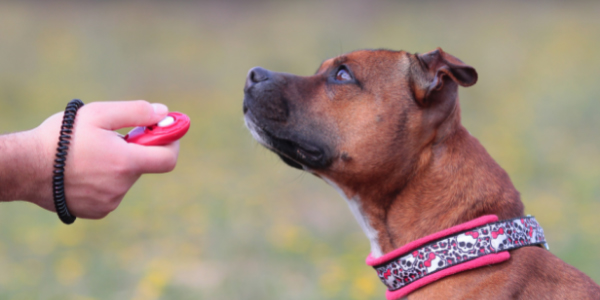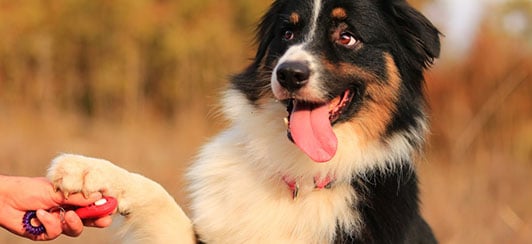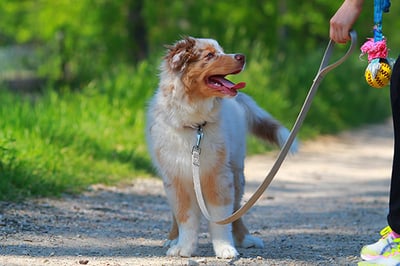 Attention is an important part of your relationship with your dog, and you can create a simple way to get your dog’s attention by teaching them their name.
Attention is an important part of your relationship with your dog, and you can create a simple way to get your dog’s attention by teaching them their name.
This can be useful in a variety of situations; it’s a wonderful way to prevent unwanted behaviors, such as barking at a passing bicycle or grabbing a piece of trash off the sidewalk. If your pup is too busy looking toward you, they can’t be barking at things or chewing on inappropriate items.
I personally use a dog's name recognition as a replacement for teaching "look at me" or "watch me."
Name recognition is the foundation for every other training cue — if your dog isn’t paying attention to you in the first place, you can’t expect them to respond to the next thing you ask for. Dogs who respond well to their name are also amazing at learning to come when called. Your dog's name is easy to teach with clicker training or with a marker word and your dog will quickly learn to love hearing their name!
Table of Contents
Is It Okay to Change Your Dog's Name?
There's nothing wrong with changing a dog's name when you first welcome them into your family. By using the technique below, teaching a new name can be helpful in building a strong and positive relationship with a newly adopted dog. In some cases, such as after being rescued from an abusive environment, a dog has a negative association with their previous name and it's best to change it to something that sounds completely different.
In my own experience, I didn't particularly like my dog's registered name she'd been given by her breeder and I wanted something a bit more relatable (Her shortened official name 'Ohso' just didn't roll off the tongue as well as 'Sookie'). My other dog was named 'Beemer' by the breeder, but the 9-year-old child in our family insisted on 'Fozzie Bear.' My last dog Mikey was given his name at the shelter, and it fit him perfectly (and he loved it!), so it stuck for life.
When choosing a new name for your dog, make sure it's one that everyone in your family will use. I also recommend keeping it short, one to two syllables at most. This makes it quick and easy to say during training or other scenarios.
If you find that you don't like your dog's given name, or if it's difficult to use consistently, follow the same steps below to teach your dog their new name. Stop using their old name when you make the switch – slowly changing their name will just make the process longer.
What You’ll Need to Teach Your Dog Their Name
- A clicker OR a marker word such as "yes!"
-
Small training treats
- A treat pouch (optional, but very convenient). My favorite and the one I use the most is the Voilà Ultimate Treat Pouch.
How to Teach Your Dog Their Name
Play the Name Game With Your Dog
- Hold a training treat in your hand, closing your fist over it.
- Hold your closed fist away from your body. Your dog will probably be staring at your hand because they know there’s a delicious treat in there and they want it.
- Say your dog’s name — just once! — and wait.
- When your dog looks towards your face, CLICK (or say "Yes!"), then give them the treat. You just had a successful name recognition cue!
Pro Tip: What if your dog keeps staring at your hand after you’ve said their name?
You have a few options:
1) Wait them out until they offer eye contact
2) Encourage them to glance at your face by making a non-verbal noise (like a whistle or kissy noise) that will entice them to look.
3) Slowly bring your closed fist towards the center of your forehead to lure eye contact.
Make sure to click or say "yes!" when they make eye contact, so they know that is was what got them their treat.
Repeat this exercise 10 to 15 times, and then finish your training session with some play. Plan for a few training sessions each day, keeping them short and fun. Check out a video of me playing this game in the next section.
Play the "Center of the Universe" Dog Training Game
This game is a great way to practice name recognition with your dog. This dog training game is fun because it keeps your dog moving and teaches them that orienting back towards you when they hear their name means good things happen. A perfect foundation that builds your dog's coming when called skills. You're the center of their universe!
- Toss a treat away from you.
- When your dog has followed that treat and just as they finish eating it, say their name!
- When they turn to look at you, click or say "yes!" and toss another treat away from you.
This video shows me playing the name game and the center of the universe game with my dog, Fozzie:
Start Easy and Without Distractions
Begin teaching this cue inside where your dog isn’t distracted before slowly making the environment more and more exciting and hard to ignore. You can increase the value of the training treat when you start introducing distractions to help your dog learn that paying attention to you is way better than what’s going on across the street. A "more valuable" treat would be something like freeze-dried raw treats or turkey hotdogs. The smellier the better!
If your dog won’t give you eye contact, consider what might be making it harder for them. Are they too distracted? Move away from the distraction and try again. Are they not interested in your food treat? Try a higher-value treat, or try again later when they are hungry.
As you practice, you can start to fade out the clicker or marker word by not clicking or marking every time they look at you when you say their name. Make sure you still reward them when they look at you when they hear their name. Praise, petting, a tug toy, throwing a ball, a food treat if you have one, or anything your dog likes will work. You want your dog to hear their name and know that it means fun is about to happen!
Fading Out Food Treats for Your Dog's Name Cue
As you progress through training, you can also fade out the use of dog treats. The goal is to replace the majority of food rewards for known training cues with real-life rewards such as play, praise, or other things your dog loves.
Read this article for more information about how to phase out the use of food treats in dog training. However, if your pup gives you an amazing performance of responding to their name when around a big distraction, go ahead and toss them a piece of chicken — they earned it!
Keep It Fun! Training Tips for Teaching Your Dog Their Name
Now that you have your dog's name on cue, make sure you use it as a training command and not something you use when not asking your dog for attention. Many dog owners use the cue "Look at Me" if they use their dog's name often, outside of asking for a behavior.
Take note if you're constantly using your dog's name outside of using it as a way to ask for their attention, such as in praise or when you're just hanging out with your pup. If you do, that's totally fine! Just don't expect your dog to know when you're using their name as a command to look at you or not.
Try not to repeat their name over and over if they don't respond the first time — this is an especially hard habit to break for us humans!
If you give the cue and they don't look your way, make a kissy noise or entice them to look at you with movement so you can reward them.
Try not to say your dog's name in a negative way, such as yelling it angrily to interrupt bad behavior, like barking out the window at the postal worker. Instead, say it as a cue to look at you instead of barking, and reward with praise, petting, play, or a food treat when they give you attention.
The more upbeat and positive you are when saying your dog's name, the more they'll look forward to hearing it, and the more likely they'll respond appropriately when they do! Plus, even when you're frustrated, the way you speak can work to calm yourself down and prevent further frustration – this is one of my favorite tricks to maintain a positive experience for both me and my dogs.




